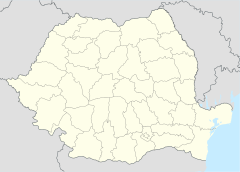Marosch-Auen Nature Park
| Marosch-Auen Nature Park | ||
|---|---|---|
| The Maroschtal in the Arad district | ||
|
|
||
| Location: | Arad , Romania | |
| Specialty: | Nature and landscape protection | |
| Next city: | Arad in Romania | |
| Surface: | 175 km² | |
| Founding: | 2005 | |
The Marosch Auen Nature Park ( Romanian Parcul Natural Lunca Mureșului ) is a nature reserve along the Mureș River ( German Marosch ) in the Arad and Timiș districts in Romania . The Marosch-Auen nature park stretches from Arad downstream to the border with Hungary . It has been a nature reserve since 2005, according to the IUCN guidelines. The Marosch-Auen nature park is open to tourists .
description
The Marosch River has shaped the region around Arad for centuries, although its natural course was repeatedly straightened by human intervention until 1910. Because of the higher flow velocity as a result of the straightening, flooding increased steadily. The frequently flooded areas provide an excellent habitat for a wide variety of plants and animals.
The floodplain landscape of the Marosch was declared a nature reserve in 2005. It covers an area of 17,455 hectares. The Marosch floodplains extend for nine kilometers along the Marosch river. There is a great variety of animal and plant species in the forests and on the oxbow lakes of the Marosch . The nature park houses an education and information center run by Ovidiu Pirv.
Flora and fauna
A total of 1200 different species and subspecies can be found in the park. Most of the 400 animal species are birds and fish. 178 of the 200 bird species are on the Red List of Endangered Species .
Among the rare species there are birds such as white-tailed eagles and little egrets , aquatic animals such as catfish and otters , and the floodplain forest is populated by wild boars and dormice . The forest, which is over 100 years old, catches the eye with its abundance of oaks and ash trees . On the banks of the Marosch there are poplars and willows .
Ecotourism
The Lunca Muresului Natural Park offers its visitors many opportunities to actively explore it. The lush green of the nature park can be easily explored by canoe, on foot or by bike. The offer ranges from hiking routes of different lengths to bike excursions and canoe tours , which can be guided by a guide from the park if necessary. The age of the visitors is usually between 25 and 55 years.
There are various destinations to choose from for the activities, including several waiting areas from which birds and other animals can be observed, or stations in which the growth of the forest and its plants is described and explained.
There are four zones within the nature park that enjoy absolute protection:
- The large gravel ( Romanian Prundul Mare ) (717.9 hectares),
- The forest of Cenad ( Romanian Pădurea Cenad ) (310.5 hectares),
- The Big Island of Cenad ( Romanian Insula Mare Cenad ) (2.1 hectares)
- The Igriș archipelago ( Romanian Insulele Igriș ) (7 hectares).
There are two historical monasteries very close to the Lunca Mureșului Natural Park : Hodoș-Bodrog from the 12th century and Bezdin , which was founded in the 16th century. Both are among the oldest of their kind in Romania. While Hodoș-Bodrog belongs to the Romanian Orthodox Church, Bezdin is one of the last remaining Serbian Orthodox monasteries in the country. Both monasteries are still inhabited today. The original wall paintings of the monasteries are still preserved.
Web links
- luncamuresului.ro , Parcul Natural Lunca Mureșului
- Umwelt-baut-bruecken.de (PDF; 950 kB), Environment builds bridges
- youtube.com , Parcul Natural Lunca Mureșului
Individual evidence
- ↑ adz.ro , ADZ , Balthasar Waitz : The Marosch-Au in 3D. Experience the nature park in ten minutes .







